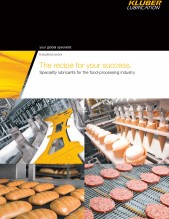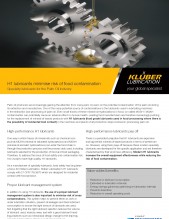NSF H1 registered lubricants minimise risk of food contamination
Palm oil producers are increasingly gaining the attention from many palm oil users on the potential contamination of the palm oil during its extraction and manufacture. One of the many potential source of contaminations is the lubricants used in lubricating machines in the extraction and processing of palm oil. Even small traces of these mineral oil hydrocarbons in food, so-called MOSH / MOAH contamination, can cause damage to human health. Leading food manufacturers are therefore increasingly pushing for the replacement of mineral oil-based products with H1 lubricants (food grade lubricants used in food-processing where there is the possibility of incidental food contact) in the machines and plants of all production steps involved in processing palm oil.
High-performance H1 lubricants
One way in which traces of mineral oils such as chemical compounds MOSH (mineral oil saturated hydrocarbons) and MOAH (mineral oil aromatic hydrocarbons) can enter the food chain is through the production process and the process aids used, including lubricants selected for the production of food and food packaging. Therefore, to address the issue of food safety and contamination risk, the need for high quality, H1 lubricants are necessary.
As a manufacturer of specialty lubricants, food safety has long been a focus for Klüber Lubrication. The tribology expert has developed numerous lubricants that meet the highest hygiene standards. Klüber Lubrication’s H1 lubricants are in compliance with 21 CFR 178.3570 issued by the United States Food and Drug Administration (FDA). That means they are designed for incidental contact with food product. In case of unavoidable food contact, according to FDA regulations, the amount of lubricant in food must not exceed 1 ppm for silicone oils and 10 ppm for all other base oils. Very small quantities of modern, innovative high-performance lubricants are sufficient to achieve the desired lubricating effect and thus reduces the risk of contamination.
In addition to using H1 lubricants, the use of a proper lubricant management system is also important to minimize risk of cross contaminations. This system helps to prevent either an over or under lubrication situation, prevent oil leakages and track lubricant consumption to ensure the right amount of lubricants are used. Not forgetting that the right lubricant selection reduces the volume of lubricant used, reduces wear, and coupled with a good lubricant handling practices such as mechanical design change to the drip tray, prevents lubricant from dripping on the food product.
High-performance lubricants pay off
There is a persistent prejudice that H1 lubricants are expensive and lag behind mineral oil-based products in terms of performance. However, using them pays off because these modern specialty lubricants are developed for the specific application and are therefore characterized by their enormous efficiency. Modern H1 lubricants increase the overall equipment effectiveness while reducing the risk of food contamination.
These specialty synthetic lubricants offer potential value-added benefits such as:
For an instance, with its superior temperature performance, using H1 synthetic gear oils shows a significant improvement in efficiency and reduction of wear. Thermal test shows considerably lower oil temperatures when using specialty synthetic gear oils, which indicates a significantly higher efficiency than standard gear oil. Synthetic gear oils based on polyalphaolefin show a considerably lower gear friction coefficient than mineral oils due to their particular molecular structure. As a result, reduced energy consumption, extended lifetime of gearbox and reduced maintenance cost can be achieved.
Learn more
Follow us on LinkedIn



